The history of the People's Law Library of Maryland, 1996-2016
People’s Progress: Looking back and looking forward, after 20 years
“How do you know where you're going unless you know where you've been?” Judge Harry Storm posed this rhetorical question introducing his review of MSBA’s history at the beginning of his year as our president. As the People’s Law Library website turns 20 years old, it seems wise to remember where we came from, and to mine our historical record for the lessons we might otherwise lose.
People’s Law is a free, plain-language public legal information and referral website geared to the needs of Maryland’s self-represented litigants. For nearly ten years, People’s Law has been maintained by the Maryland State Law Library, and is publically available at www.peoples-law.org. In the library’s most recent fiscal year, People’s Law served just over 2.1 million pageviews to users throughout Maryland, the United States, and the world.
But though its mission has always been to use new technology to increase access to justice for Marylanders, for the first half of its existence, People’s Law did not live in a library, the judicial branch, or even the government. The site was developed at a law school, and was supported by funders and providers of civil legal services before finding the home that now seems so fitting.
Law School origins
If necessity is the mother of invention, academic institutions often feature strongly in the birth process. In the mid-1990s the Administrative Office of the Courts made grants to Maryland’s two law schools to pilot a program designed to help self-represented litigants in domestic cases. The University of Maryland created the Assisted Pro Se Clinic, in which Richard Granat, Michael Millemann, and Natalie Gilfrich led a team of clinical law students in assisting litigants in person in courthouses.
When Granat saw the numbers of cases, and saw that many people had relatively straightforward problems that could be successfully navigated with clear legal information, he was inspired to use emerging technology to create an online library of information to, where appropriate, help people help themselves.
In 1995, UM received a grant from the Abell Foundation, to create a website that included family law forms and explanations (the new domestic relations forms were among the first content on People’s Law). In the grant application, UM stated that, if successful, such a project would likely have application in other areas of the law, including landlord-tenant law, educational disability law, and elder law. People’s Law launched in December 1996.
Though People’s Law was launched with a focus on family law, as early as April 1997, the front page of the site stated, “The Library covers many areas of the law that affect people in their daily lives from family law to consumer law to landlord/tenant law. In some sections of the Library, legal forms can now be completed on-line and come with detailed instructions on how to use them.”
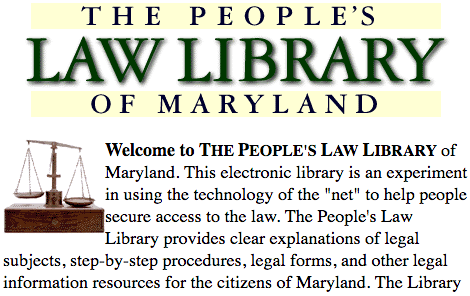
April 15, 1997
Starting People’s Law entailed risk – could unknown technology successfully fill in gaps in the justice system? If so, which gaps were best suited to the medium of a website? A law clinic provided an ideal incubation. The students brought energy to the endeavor and gained experience that could be used to determine which content was appropriate.
However, the law clinic could not provide the site with a long-term home. Law clinics may not have the stable funding or personnel required to support a venture in the long term. When initial funding ran out, Granat continued to maintain PLL as a volunteer, and sought other funding. So began the transition of People’s Law to its next home.
Maturing the site – Maryland’s “Legal Services” community
In 1998, the Maryland Legal Services Corporation (MLSC) received a grant from the Open Society Institute (OSI) to create an entity called Maryland Legal Assistance Network (MLAN). MLAN was created to work toward several goals, one of which was the further development of the People’s Law Library. Robert Rhudy, then executive director of MLSC, hired Ayn Crawley to manage MLAN, and Crawley became the leader of the People’s Law Library.
By February 1999, People’s Law went offline for technology updates and content expansion. Civil Justice, another Baltimore-based legal nonprofit, was hired to produce some of the new content.
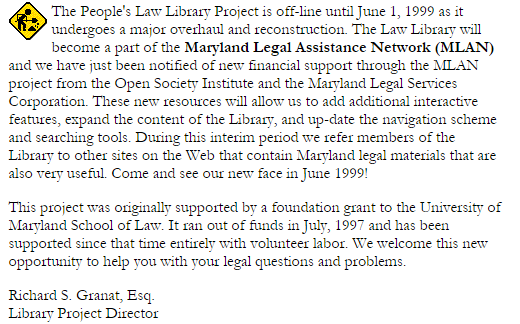
March 2, 1999
When the site came back online later in 1999, it included the now characteristic list of topical subject areas. Some of the topic areas primarily aggregated links to other sites, while others contained significant content on the site.
As early as 2000, People’s Law worked with libraries and senior centers to provide legal information outreach. Eventually, computers would be placed in a variety of locations around the state, to enable the public to access free legal information.
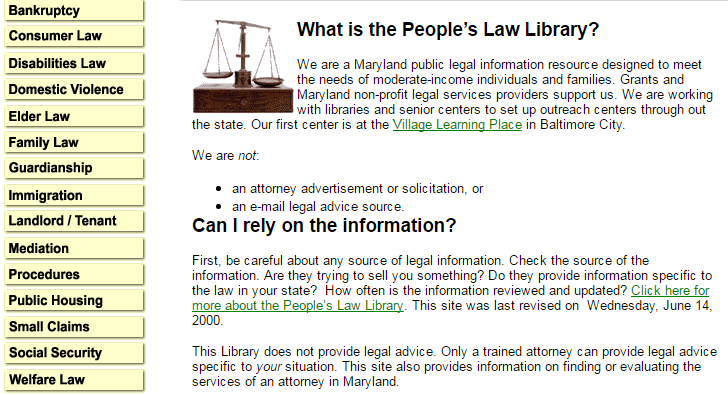
June 14, 2000
Crawley envisioned People’s Law as an integrated approach to legal services for low and moderate income people, helping people understand their possible remedies, and providing diagnostic tools to help them evaluate their likelihood of success in going to court. For people with no alternative, the site provided a level of information and guidance that was better than nothing. For those deciding whether or not to represent themselves, the site included tools and assessments designed to objectively warn people of the risks and challenges, and help people make an informed decision.
The scope of content continued to grow at this time as well. Crawley worked with committees to conceptualize new content, which was written by a mixture of attorneys and law students.
Throughout this time, Crawley and Rhudy considered future funding for the project. The original OSI funding lasted through mid-2001. The following year, the Legal Aid Bureau of Maryland received a two-year technology grant from the Legal Services Corporation (LSC), a national funder of civil legal services. The grant, designed to use the internet to help self-represented litigants, was submitted as a partnership between Maryland Legal Aid and MLAN, with the involvement of Maryland Volunteer Lawyers Service, the Women’s Law Center of Maryland and the Chicago-Kent law school.
As the LSC grant period wound down, People’s Law again needed an on-going home. In August 2004, the Maryland Legal Assistance Network was transferred from the Maryland Legal Services Corporation to the Legal Aid Bureau, and Crawley remained the primary leader of the project.
Crawley was nationally recognized in 2005, receiving the American Association of Law Libraries Public Access to Government Information award for her work with the People’s Law Library. This award recognizes “persons or organizations that have made significant contributions to protect and promote greater public access to government information.”
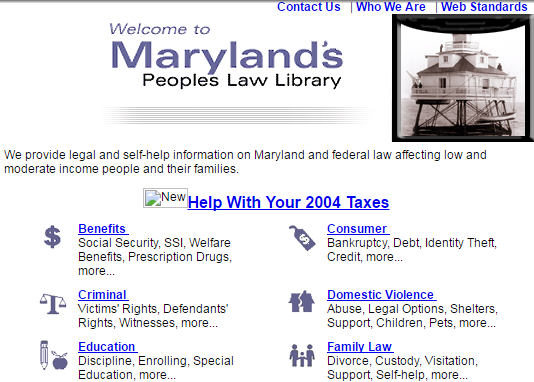
February 4, 2005
By 2007, the funding previously secured for MLAN was exhausted. During this transition, the Legal Aid Bureau voluntarily continued to support MLAN’s projects, including People’s Law. However, because the mission of Legal Aid was geared more toward providing full-service advocacy to individual clients than to maintaining general legal information, they continued to seek a permanent home for the site.
An institutional home – Maryland State Law Library
The leading candidate was the Maryland State Law Library (MSLL), which had long been involved in the shaping and promotion of the information on People’s Law. A court-related agency of the Maryland judiciary, MSLL was a historically stable institutional leader in gathering, synthesizing, and providing legal information, and made an ideal location for the project. Later that year, Legal Aid transferred People’s Law to the library, where it has remained since.
The agreement making the transfer was signed in November 2007, by Wilhelm Joseph, Executive Director of the Legal Aid Bureau and then Chief Judge Robert Bell of the Maryland Court of Appeals. The document stated that People’s Law “is an integral piece of Maryland’s system for delivery of legal information and services to the State’s low- and moderate-income residents,” and that “the goals and objectives of PLL are best achieved if it is placed in an environment focused on knowledge management that could maximize its potential value to low- and moderate-income Maryland residents.”
Chief Judge Bell had long been a supporter of the site. Indeed, as he approached retirement, the Chief Judge wrote a personal reflection on the achievements in his time as chief judge. His reflection, published in the Judges Journal, discussed the barriers confronting court litigants, and the role of People’s Law in providing access to justice.
After taking on People’s Law, the State Law Library hired a web content coordinator. The first long-term web content coordinator was Michael Craven, trained as both a lawyer and a librarian. Craven solidified the technology behind the site, removing duplicative content and bringing content that had been interlaced on two servers into a single repository. Working closely with an advisory panel called the Content Advisory Committee, Craven reorganized and refocused the effort, targeting for development primarily content addressing topics that relate to civil cases most frequently involving self-represented parties in state courts.
In reorganizing and rebuilding the site, Craven used an open source content management system called Drupal. With a database structure, the Drupal system required more technical insight than some prior versions, but allowed for multiple login accounts, and a modern editorial workflow. This theoretically enabled different people to manage different content regions on the site, though most of the actual updating was still done by Craven and others at the State Law Library, with offline input from volunteers and members of the Content Advisory Committee.
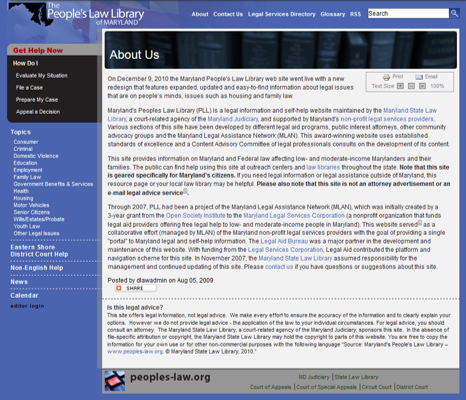
December 30, 2010
Initially, Craven used a Drupal implementation called DLAW (Drupal for Legal Aid Websites) that had been developed by Urban Insight. Eventually, he developed his own implementation, based on the DLAW version.
In 2011, People’s Law won two more awards. In July, the American Association of Law Libraries awarded People’s Law with the Innovation in Technology award, and in December, the Maryland Legal Services Corporation gave the site the Herbert S. Garten Public Citizen award.
When Craven took another position in 2013, the State Law Library hired Dave Pantzer, a Maryland lawyer with an information technology background. Pantzer’s primary focus has been to build on People’s Law’s existing relationships within the legal community, and to develop new relationships with law schools and colleges, Bar Associations, government agencies, courthouse personnel, legal services organizations, public libraries, and the private bar.
In 2013, the Pro Bono Resource Center started promoting writing and editing content on People’s Law as a reportable form of pro bono service. The following year, the Office of the Attorney General started promoting pro bono service to the site for its attorneys. Law school clinics have partnered with People’s Law to serve the public and give students practical writing experiences, and translation classes at Towson University and the University of Maryland have expanded the non-English content.
People’s Law started offering training on writing about the law in plain English, and started tracking and recognizing contributors. State Law Library personnel travel throughout the state, training courthouse staff and public librarians about legal information resources, and how they can point self-represented people to People’s Law, law libraries, and other resources, and provide appropriate referrals for legal help.
Pantzer oversaw a major technology upgrade in 2014. This upgrade allowed the site to work smoothly on smartphones and other mobile devices, which now account for over half of the site’s use.
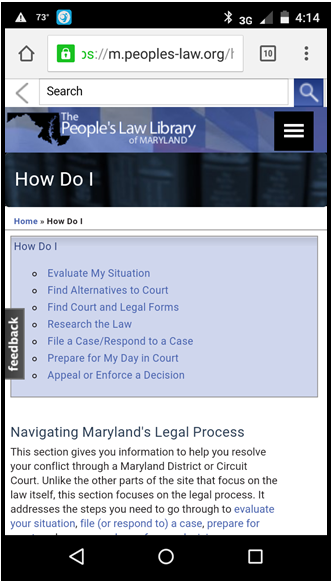
Mobile screen shot, 2016
In 2015, the People’s Law Content Advisory Committee was sunset as part of a broad reorganization of committees within the judiciary. That same year, the library started the “People’s Law Fellows” program, hiring 2-3 law students or recent graduates annually, to assist with research and writing.
The more things change…
People’s Law has travelled a winding road. The site was born in a law clinic, raised by a state legal services funder, supported by the state’s primary provider of civil legal aid, and now resides in the doubly neutral environment of the judiciary’s flagship law library. Even the web address has been through .com, .info, and .org extensions. The funding of People’s Law reflects the maturing process of a successful project, from grants to institutional budgeting.
Still today, the strength of People’s Law lies in the diversity of its contributors, who come from every part of the legal community. Students have also remained important to the project, from the beginnings at UM Law, through the MLAN years, and more recently, as clinical law students, translation students and People’s Law fellows have contributed to the site.
Other themes emerge as common threads across the site’s history. Looking back, Richard Granat reflects, “The original vision was that the people own the law, not the lawyers, and to facilitate access to the legal system people need to know and understand what the law is. Self-representation is also a constitutional right, so the idea of the Library was to facilitate self-representation when appropriate.” Ayn Crawley echoes a similar theme, pointing out that every person has a right to the legal system. Her vision of People’s Law as an integrated toolkit aimed to challenge a legacy of legal complexity, and move toward the goal that individuals would have real access to the courts.
So what’s on the horizon?
As People’s Law passes the twenty year mark, it is gearing up for several future opportunities.
First, in order to grow its non-English content, People’s Law is integrating state-of-the-art translation memory and support. This technology will flag small units of source text as they change, prompting volunteers to retranslate just those units, and providing a variety of tools to make the work easier.
Second, as new innovations emerge in the practice of law, the demand for clear, reliable legal information will grow. Limited scope practice, long an option in Maryland, has recently been bolstered by new rules allowing lawyers to make limited appearances. As lawyers and clients carefully craft task-sharing arrangements, clients need practical information to support them.
Finally, People’s Law has an opportunity to provide leadership in the area of public legal information. Many organizations provide a narrow band of information, advice, or representation, tailored to a specific topic or audience. Two challenges emerge. First, when many organizations provide similar content, the time and money spent updating and translating duplicative text is wasted.
Second, legal needs often come in clusters. Seemingly unrelated issues like divorce, eviction, support, bankruptcy, debt, and small claims may involve multiple courts and multiple sources of legal help. A client may find that no one source of help fully addresses their needs.
Both of these information challenges (coordinating the sharing of similar content across institutions; and organizing and promoting diverse content from many institutions) are best served by a trusted partner that is understood to be neutral. And it is here that libraries are directly within their sphere of competence, and perhaps why People’s Law was always called a library, and, after many stops, came to rest in a library.
Naming the site in the early days of the web, Granat envisioned a future in which all physical libraries would have a virtual dimension. Twenty years on, the People’s Law Library continues to work with the whole community to develop clear information that helps the public understand options and make informed decisions.
https://web.archive.org/web/19970415135100/http://www.peoples-law.com/